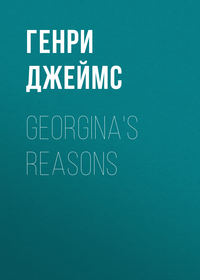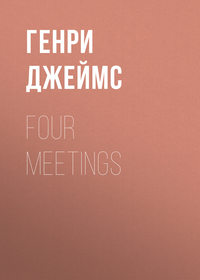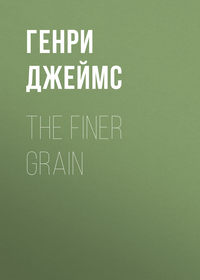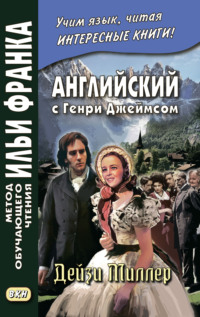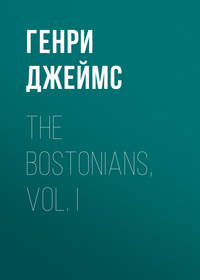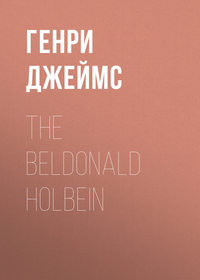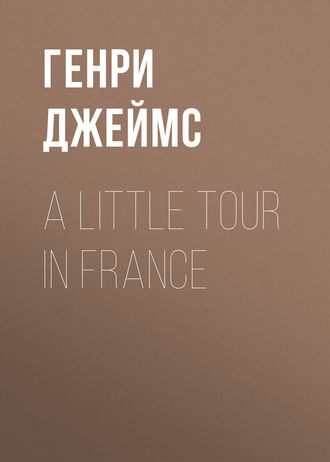 полная версия
полная версияA Little Tour in France
But we must not take the Chateau de Blois too hard: I went there, after all, by way of entertainment. If among these sinister memories your visit should threaten to prove a tragedy, there is an excellent way of removing the impression. You may treat yourself at Blois to a very cheerful afterpiece. There is a charming industry practised there, and practised in charming conditions. Follow the bright little quay down the river till you get quite out of the town, and reach the point where the road beside the Loire be- comes sinuous and attractive, turns the corner of dimi- nutive headlands, and makes you wonder what is be- yond. Let not your curiosity induce you, however, to pass by a modest white villa which overlooks the stream, enclosed in a fresh little court; for here dwells an artist, – an artist in faience. There is no sort of sign, and the place looks peculiarly private. But if you ring at the gate, you will not be turned away. You will, on the contrary, be ushered upstairs into a parlor – there is nothing resembling a shop- encum- bered with specimens – of remarkably handsome pottery. The work is of the best, – a careful reproduction of old forms, colors, devices; and the master of the establishment is one of those completely artistic types that are often found in France. His reception is as friendly as his work is ingenious; and I think it is not too much to say that you like the work the better be- cause he has produced it. His vases, cups and jars, lamps, platters, plaques, with their brilliant glaze, their innumerable figures, their family likeness, and wide variations, are scattered, through his occupied rooms; they serve at once as his stock-in-trade and as house- hold ornament. As we all know, this is an age of prose, of machinery, of wholesale production, of coarse and hasty processes. But one brings away from the establishment of the very intelligent M. Ulysse the sense of a less eager activity and a greater search for perfection. He has but a few workmen, and he gives them plenty of time. The place makes a little vignette, leaves an impression, – the quiet white house in its garden on the road by the wide, clear river, without the smoke, the bustle, the ugliness, of so much of our modern industry. It ought to gratify Mr. Ruskin.
V
The second time I went to Blois I took a carriage for Chambord, and came back by the Chateau de Cheverny and the forest of Russy, – a charming little expedition, to which the beauty of the afternoon (the finest in a rainy season that was spotted with bright days) contributed not a little. To go to Chambord, you cross the Loire, leave it on one side, and strike away through a country in which salient features be- come less and less numerous, and which at last has no other quality than a look of intense, and peculiar rurality, – the characteristic, even when it is not the charm, of so much of the landscape of France. This is not the appearance of wildness, for it goes with great cultivation; it is simply the presence of the delving, drudging, economizing peasant. But it is a deep, unrelieved rusticity. It is a peasant's landscape; not, as in England, a landlord's. On the way to Cham- bord you enter the flat and sandy Sologne. The wide horizon opens out like a great potager, without inter- ruptions, without an eminence, with here and there a long, low stretch of wood. There is an absence of hedges, fences, signs of property; everything is ab- sorbed in the general flatness, – the patches of vine- yard, the scattered cottages, the villages, the children (planted and staring and almost always pretty), the women in the fields, the white caps, the faded blouses, the big sabots. At the end of an hour's drive (they assure you at Blois that even with two horses you will spend double that time), I passed through a sort of gap in a wall, which does duty as the gateway of the domain of an exiled pretender. I drove along a straight avenue, through a disfeatured park, – the park of Chambord has twenty-one miles of circumference, – a very sandy, scrubby, melancholy plantation, in which the timber must have been cut many times over and is to-day a mere tangle of brushwood. Here, as in so many spots in France, the traveller perceives that he is in a land of revolutoins. Nevertheless, its great ex- tent and the long perspective of its avenues give this desolate boskage a certain majesty; just as its shabbi- ness places it in agreement with one of the strongest impressions of the chateau. You follow one of these long perspectives a proportionate time, and at last you see the chimneys and pinnacles of Chambord rise ap- parently out of the ground. The filling-in of the wide moats that formerly surrounded it has, in vulgar par- lance, let it down, bud given it an appearance of top- heaviness that is at the same time a magnificent Orien- talism. The towers, the turrets, the cupolas, the gables, the lanterns, the chimneys, look more like the spires of a city than the salient points of a single building. You emerge from the avenue and find yourself at the foot of an enormous fantastic mass. Chambord has a strange mixture of society and solitude. A little village clusters within view of its stately windows, and a couple of inns near by offer entertainment to pilgrims. These things, of course, are incidents of the political pro- scription which hangs its thick veil over the place. Chambord is truly royal, – royal in its great scale, its grand air, its indifference to common considerations. If a cat may look at a king, a palace may lock at a tavern. I enjoyed my visit to this extraordinary struc- ture as much as if I had been a legitimist; and indeed there is something interesting in any monument of a great system, any bold presentation of a tradition.
You leave your vehicle at one of the inns, which are very decent and tidy, and in which every one is very civil, as if in this latter respect the influence of the old regime pervaded the neighborhood, and you walk across the grass and the gravel to a small door, – a door infinitely subordinate and conferring no title of any kind on those who enter it. Here you ring a bell, which a highly respectable person answers (a per- son perceptibly affiliated, again, to the old regime), after which she ushers you across a vestibule into an inner court. Perhaps the strongest impression I got at Chambord came to me as I stood in this court. The woman who admitted me did not come with me; I was to find my guide somewhere else. The specialty of Chambord is its prodigious round towers. There are, I believe, no less than eight of them, placed at each angle of the inner and outer square of buildings; for the castle is in the form of a larger structure which encloses a smaller one. One of these towers stood before me in the court; it seemed to fling its shadow over the place; while above, as I looked up, the pinnacles and gables, the enormous chimneys, soared into the bright blue air. The place was empty and silent; shadows of gargoyles, of extra- ordinary projections, were thrown across the clear gray surfaces. One felt that the whole thing was monstrous. A cicerone appeared, a languid young man in a rather shabby livery, and led me about with a mixture of the impatient and the desultory, of con- descension and humility. I do not profess to under- stand the plan of Chambord, and I may add that I do not even desire to do so; for it is much more entertaining to think of it, as you can so easily, as an irresponsible, insoluble labyrinth. Within, it is a wilderness of empty chambers, a royal and romantic barrack. The exiled prince to whom it gives its title has not the means to keep up four hundred rooms; he contents himself with preserving the huge outside. The repairs of the prodigious roof alone must absorb a large part of his revenue. The great feature of the interior is the celebrated double staircase, rising straight through the building, with two courses of steps, so that people may ascend and descend without meeting. This staircase is a truly majestic piece of humor; it gives you the note, as it were, of Chambord. It opens on each landing to a vast guard-room, in four arms, radiations of the winding shaft. My guide made me climb to the great open-work lantern which, springing from the roof at the termination of the rotund staircase (surmounted here by a smaller one), forms the pinnacle of the bristling crown of Cham- bord. This lantern is tipped with a huge fleur-de-lis in stone, – the only one, I believe, that the Revolution did not succeed in pulling down. Here, from narrow windows, you look over the wide, flat country and the tangled, melancholy park, with the rotation of its straight avenues. Then you walk about the roof, in a complication of galleries, terraces, balconies, through the multitude of chimneys and gables. This roof, which is in itself a sort of castle in the air, has an extravagant, faboulus quality, and with its profuse ornamentation, – the salamander of Francis I. is a con- tant motive, – its lonely pavements, its sunny niches, the balcony that looks down over the closed and grass-grown main entrance, a strange, half-sad, half- brilliant charm. The stone-work is covered with fine mould. There are places that reminded me of some of those quiet, mildewed corners of courts and ter- races, into which the traveller who wanders through the Vatican looks down from neglected windows. They show you two or three furnished rooms, with Bourbon portraits, hideous tapestries from the ladies of France, a collection of the toys of the enfant du miracle, all military and of the finest make. "Tout cela fonc- tionne," the guide said of these miniature weapons; and I wondered, if he should take it into his head to fire off his little canon, how much harm the Comte de Chambord would do.
From below, the castle would look crushed by the redundancy of its upper protuberances if it were not for the enormous girth of its round towers, which appear to give it a robust lateral development. These towers, however, fine as they are in their way, struck me as a little stupid; they are the exaggeration of an exaggeration. In a building erected after the days of defence, and proclaiming its peaceful character from its hundred embroideries and cupolas, they seem to indicate a want of invention. I shall risk the ac- cusation of bad taste if I say that, impressive as it is, the Chateau de Chambord seemed to me to have al- together a little of that quality of stupidity. The trouble is that it represents nothing very particular; it has not happened, in spite of sundry vicissitudes, to have a very interesting history. Compared with that of Blois and Amboise, its past is rather vacant; and one feels to a certain extent the contrast between its pompous appearance and its spacious but some- what colorless annals. It had indeed the good for- tune to be erected by Francis I., whose name by itself expresses a good deal of history. Why he should have built a palace in those sandy plains will ever remain an unanswered question, for kings have never been obliged to give reasons. In addition to the fact that the country was rich in game and that Francis was a passionate hunter, it is suggested by M. de la Saussaye, the author of the very complete little history of Chambord which you may buy at the bookseller's at Blois, that he was govemed in his choice of the site by the accident of a charming woman having formerly lived there. The Comtesse de Thoury had a manor in the neighborhood, and the Comtesse de Thoury had been the object of a youthful passion on the part of the most susceptible of princes before his accession to the throne. This great pile was reared, therefore, according to M. de la Saussaye, as a souvenir de premieres amours! It is certainly a very massive memento; and if these tender passages were propor- tionate to the building that commemorates them, they were tender indeed. There has been much discus- sion as to the architect employed by Francis I., and the honor of having designed this splendid residence has been claimed for several of the Italian artists who early in the sixteenth century came to seek patronage in France. It seems well established to-day, however, that Chambord was the work neither of Primaticcio, of Vignola, nor of Il Rosso, all of whom have left some trace of their sojourn in France; but of an obscure yet very complete genius, Pierre Nepveu, known as Pierre Trinqueau, who is designated in the papers which preserve in some degree the history of the origin of the edifice, as the maistre de l'oeuvre de maconnerie. Behind this modest title, apparently, we must recognize one of the most original talents of the French Renaissance; and it is a proof of the vigor of the artistic life of that period that, brilliant pro- duction being everywhere abundant, an artist of so high a value should not have been treated by his con- temporaries as a celebrity. We manage things very differently to-day.
The immediate successors of Francis I. continued to visit, Chambord; but it was neglected by Henry IV., and was never afterwards a favorite residence of any French king. Louis XIV. appeared there on several occasions, and the apparition was characteristically brilliant; but Chambord could not long detain a monarch who had gone to the expense of creating a Versailles ten miles from Paris. With Versailles, Fon- tainebleau, Saint-Germain, and Saint-Cloud within easy reach of their capital, the later French sovereigns had little reason to take the air in the dreariest province of their kingdom. Chambord therefore suffered from royal indifference, though in the last century a use was found for its deserted halls. In 1725 it was oc- cupied by the luckless Stanislaus Leszczynski, who spent the greater part of his life in being elected King of Poland and being ousted from his throne, and who, at this time a refugee in France, had found a compensation for some of his misfortunes in marry- ing his daughter to Louis XV. He lived eight years at Chambord, and filled up the moats of the castle. In 1748 it found an illustrious tenant in the person of Maurice de Saxe, the victor of Fontenoy, who, how- ever, two years after he had taken possession of it, terminated a life which would have been longer had he been less determined to make it agreeable. The Revolution, of course, was not kind to Chambord. It despoiled it in so far as possible of every vestige of its royal origin, and swept like a whirlwind through apartments to which upwards of two centuries had contributed a treasure of decoration and furniture. In that wild blast these precious things were destroyed or forever scattered. In 1791 an odd proposal was made to the French Government by a company of English Quakers who had conceived the bold idea of establishing in the palace a manufacture of some peaceful commodity not to-day recorded. Napoleon allotted Chambord, as a "dotation," to one of his marshals, Berthier, for whose benefit it was converted, in Napoleonic fashion, into the so-called principality of Wagram. By the Princess of Wagram, the marshal's widow, it was, after the Restoration, sold to the trustees of a national subscription which had been established for the purpose of presenting it to the in- fant Duke of Bordeaux, then prospective King of France. The presentation was duly made; but the Comte de Chambord, who had changed his title in recognition of the gift, was despoiled of his property by the Government of Louis Philippe. He appealed for redress to the tribunals of his country; and the consequence of his appeal was an interminable litiga- tion, by which, however, finally, after the lapse of twenty-five years, he was established in his rights. In 1871 he paid his first visit to the domain which had been offered him half a century before, a term of which he had spent forty years in exile. It was from Chambord that he dated his famous letter of the 5th of July of that year, – the letter, directed to his so- called subjects, in which he waves aloft the white flag of the Bourbons. This amazing epistle, which is virtually an invitation to the French people to re- pudiate, as their national ensign, that immortal tricolor, the flag of the Revolution and the Empire, under which they have, won the glory which of all glories has hitherto been dearest to them, and which is as- sociated with the most romantic, the most heroic, the epic, the consolatory, period of their history, – this luckless manifesto, I say, appears to give the measure of the political wisdom of the excellent Henry V. It is the most factitious proposal ever addressed to an eminently ironical nation.
On the whole, Chambord makes a great impression; and the hour I was, there, while the yellow afternoon light slanted upon the September woods, there was a dignity in its desolation. It spoke, with a muffled but audible voice, of the vanished monarchy, which had been so strong, so splendid, but to-day has be- come a sort of fantastic vision, like the cupolas and chimneys that rose before me. I thought, while I lingered there, of all the fine things it takes to make up such a monarchy; and how one of them is a su- perfluity of mouldering, empty, palaces. Chambord is touching, – that is the best word for it; and if the hopes of another restoration are in the follies of the Republic, a little reflection on that eloquence of ruin ought to put the Republic on its guard. A sentimental tourist may venture to remark that in the presence of several chateaux which appeal in this mystical manner to the retrospective imagination, it cannot afford to be foolish. I thought of all this as I drove back to Blois by the way of the Chateau de Cheverny. The road took us out of the park of Chambord, but through a region of flat woodland, where the trees were not mighty, and again into the prosy plain of the Sologne, – a thankless soil, all of it, I believe, but lately much amended by the magic of cheerful French industry and thrift. The light had already begun to fade, and my drive reminded me of a passage in some rural novel of Madame Sand. I passed a couple of timber and plaster churches, which looked very old, black, and crooked, and had lumpish wooden porches and galleries encircling the base. By the time I reached Cheverny, the clear twilight had approached. It was late to ask to be allowed to visit an inhabited house; but it was the hour at which I like best to visit almost anything. My coachman drew up before a gateway, in a high wall, which opened upon a short avenue, along which I took my way on foot; the coachmen in those parts being, for reasons best known to them- selves, mortally averse to driving up to a house. I answered the challenge of a very tidy little portress, who sat, in company with a couple of children, en- joying the evening air in, front of her lodge, and who told me to walk a little further and turn to the right. I obeyed her to the letter, and my turn brought me into sight of a house as charming as an old manor in a fairy tale. I had but a rapid and partial view of Cheverny; but that view was a glimpse of perfection. A light, sweet mansion stood looking over a wide green lawn, over banks of flowers and groups of trees. It had a striking character of elegance, produced partly by a series of Renaissance busts let into circular niches in the facade. The place looked so private, so reserved, that it seemed an act of violence to ring, a stranger and foreigner, at the graceful door. But if I had not rung I should be unable to express – as it is such a pleasure to do – my sense of the exceeding courtesy with which this admirable house is shown. It was near the dinner-hour, – the most sacred hour of the day; but I was freely conducted into the inhabited apartments. They are extremely beautiful. What I chiefly remember is the charming staircase of white embroidered stone, and the great salle des gardes and chambre a coucher du roi on the second floor. Che- verny, built in 1634, is of a much later date than the other royal residences of this part of France; it be- longs to the end of the Renaissance, and has a touch of the rococo. The guard-room is a superb apartment; and as it contains little save its magnificent ceiling and fireplace and certain dim tapestries on its walls, you the more easily take the measure of its noble proportions. The servant opened the shutters of a single window, and the last rays of the twilight slanted into the rich brown gloom. It was in the same pic- turesque fashion that I saw the bedroom (adjoining) of Henry IV., where a legendary-looking bed, draped in folds long unaltered, defined itself in the haunted dusk. Cheverny remains to me a very charming, a partly mysterious vision. I drove back to Blois in the dark, some nine miles, through the forest of Russy, which belongs to the State, and which, though con- sisting apparently of small timber, looked under the stars sufficiently vast and primeval. There was a damp autumnal smell and the occasional sound of a stirring thing; and as I moved through the evening air I thought of Francis I. and Henry IV.
VI
You may go to Amboise either from Blois or from Tours; it is about half-way between these towns. The great point is to go, especially if you have put it off repeatedly; and to go, if possible, on a day when the great view of the Loire, which you enjoy from the battlements and terraces, presents itself under a friendly sky. Three persons, of whom the author of these lines was one, spent the greater part of a perfect Sunday morning in looking at it. It was astonishing, in the course of the rainiest season in the memory of the oldest Tourangeau, how many perfect days we found to our hand. The town of Amboise lies, like Tours, on the left bank of the river, a little white- faced town, staring across an admirable bridge, and leaning, behind, as it were, against the pedestal of rock on which the dark castle masses itself. The town is so small, the pedestal so big, and the castle so high and striking, that the clustered houses at the base of the rock are like the crumbs that have fallen from a well-laden table. You pass among them, however, to ascend by a circuit to the chateau, which you attack, obliquely, from behind. It is the property of the Comte de Paris, another pretender to the French throne; having come to him remotely, by inheritance, from his ancestor, the Duc de Penthievre, who toward the close of the last century bought it from the crown, which had recovered it after a lapse. Like the castle of Blois it has been injured and defaced by base uses, but, unlike the castle of Blois, it has not been com- pletely restored. "It is very, very dirty, but very curious," – it is in these terms that I heard it described by an English lady, who was generally to be found engaged upon a tattered Tauchnitz in the little salon de lecture of the hotel at Tours. The description is not inaccurate; but it should be said that if part of the dirtiness of Amboise is the result of its having served for years as a barrack and as a prison, part of it comes from the presence of restoring stone-masons, who have woven over a considerable portion of it a mask of scaffolding. There is a good deal of neatness as well, and the restoration of some of the parts seems finished. This process, at Amboise, consists for the most part of simply removing the vulgar excrescences of the last two centuries.
The interior is virtually a blank, the old apart- ments having been chopped up into small modern rooms; it will have to be completely reconstructed. A worthy woman, with a military profile and that sharp, positive manner which the goodwives who show you through the chateaux of Touraine are rather apt to have, and in whose high respectability, to say nothing of the frill of her cap and the cut of her thick brown dress, my companions and I thought we discovered the particular note, or nuance, of Orleanism, – a com- petent, appreciative, peremptory person, I say, – at- tended us through the particularly delightful hour we spent upon the ramparts of Amboise. Denuded and disfeatured within, and bristling without with brick- layers' ladders, the place was yet extraordinarily im- pressive and interesting. I should confess that we spent a great deal of time in looking at the view. Sweet was the view, and magnificent; we preferred it so much to certain portions of the interior, and to oc- casional effusions of historical information, that the old lady with the prove sometimes lost patience with us. We laid ourselves open to the charge of pre- ferring it even to the little chapel of Saint Hubert, which stands on the edge of the great terrace, and has, over the portal, a wonderful sculpture of the mi- raculous hunt of that holy man. In the way of plastic art this elaborate scene is the gem of Amboise. It seemed to us that we had never been in a place where there are so many points of vantage to look down from. In the matter of position Amboise is certainly supreme among the old houses of the Loire; and I say this with a due recollection of the claims of Chau- mont and of Loches, – which latter, by the way (ex- cuse the afterthought), is not on the Loire. The plat- forms, the bastions, the terraces, the high-perched windows and balconies, the hanging gardens and dizzy crenellations, of this complicated structure, keep you in perpetual intercourse with an immense horizon. The great feature of the-place is the obligatory round tower which occupies the northern end of it, and which has now been, completely restored. It is of astounding size, a fortress in itself, and contains, instead of a staircase, a wonderful inclined plane, so wide and gradual that a coach and four may be driven to the top. This colossal cylinder has to-day no visible use; but it corresponds, happily enough, with the great circle of the prospect. The gardens of Am- boise, perched in the air, covering the irregular rem- nants of the platform on which the castle stands, and making up in picturesqueness what they lack in ex- tent, constitute of come but a scanty domain. But bathed, as we found them, in the autumn sunshine, and doubly private from their aerial site, they offered irresistible opportunities for a stroll, interrupted, as one leaned against their low parapets, by long, con- templative pauses. I remember, in particular, a certain terrace, planted with clipped limes, upon which we looked down from the summit of the big tower. It seemed from that point to be absolutely necessary to one's happiness to go down and spend the rest of the morning there; it was an ideal place to walk to and fro and talk. Our venerable conductress, to whom our relation had gradually become more filial, per- mitted us to gratify this innocent wish, – to the extent, that is, of taking a turn or two under the mossy tilleuls. At the end of this terrace is the low door, in a wall, against the top of which, in 1498, Charles VIII., ac- cording to an accepted tradition, knocked his head to such good purpose that he died. It was within the walls of Amboise that his widow, Anne of Brittany, already in mourning for three children, two of whom we have seen commemorated in sepulchral marble at Tours, spent the first violence of that grief which was presently dispelled by a union with her husband's cousin and successor, Louis XII. Amboise was a fre- quent resort of the French Court during the sixteenth century; it was here that the young Mary Stuart spent sundry hours of her first marriage. The wars of re- ligion have left here the ineffaceable stain which they left wherever they passed. An imaginative visitor at Amboise to-day may fancy that the traces of blood are mixed with the red rust on the crossed iron bars of the grim-looking balcony, to which the heads of the Huguenots executed on the discovery of the con- spiracy of La Renaudie are rumored to have been suspended. There was room on the stout balustrade – an admirable piece of work – for a ghastly array. The same rumor represents Catherine de' Medici and the young queen as watching from this balcony the noyades of the captured Huguenots in the Loire. The facts of history are bad enough; the fictions are, if possible, worse; but there is little doubt that the future Queen of Scots learnt the first lessons of life at a horrible school. If in subsequent years she was a prodigy of innocence and virtue, it was not the fault of her whilom ??? mother-in-law, of her uncles of the house of Guise, or of the examples presented to her either at the windows of the castle of Amboise or in its more pri- vate recesses.





